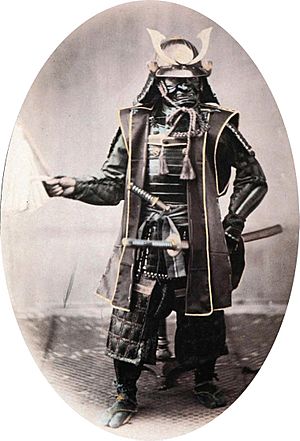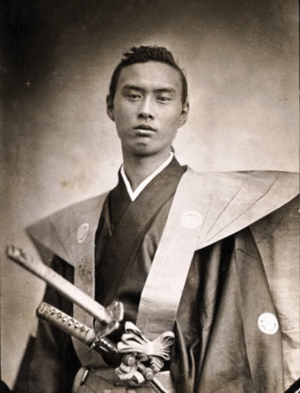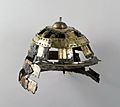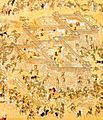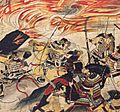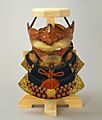Samurai facts for kids
The samurai (also called bushi) were powerful Japanese warriors. They belonged to a very important military group in Japan for many centuries. Samurai were also like a special family of nobles, meaning their position was passed down through generations.
The word samurai comes from the Japanese word saburau. This word means "to serve and look up to someone." It shows that samurai were loyal and served their leaders.
Contents
The Story of the Samurai
Early Days and First Shogun
Around the 12th century, two strong military families, the Minamoto and the Taira, fought for control of Japan. In 1192, a leader named Minamoto no Yoritomo became the first shogun. A shogun was like a military ruler of all Japan. He started a new government in a place called Kamakura. This Kamakura government lasted from 1185 to 1333. During this time, the samurai became the most important group in Japanese society.
The Warring States Period
The samurai fought many battles during a time known as the Warring States period (1467-1573). Japan was divided into many small areas, and each area often fought against others. This meant there was a great need for skilled samurai warriors. Many famous samurai movies, like those by Akira Kurosawa, tell stories from this exciting time.
Unifying Japan and New Rules
Later, a powerful leader named Toyotomi Hideyoshi won many wars. He helped unite Japan into one country. He also created a strict social system. This system was made even stronger by Tokugawa Ieyasu and the leaders who came after him.
Before this, many samurai also worked on farms. But Hideyoshi made a new rule: all samurai had to either live on farms or move to castle towns with other warriors. He also made a law that only samurai were allowed to carry swords. This made them very special.
Peaceful Times and Changes
Near the end of the Edo period (1603-1867), the samurai were still very important. They were the highest social group. All samurai had to live in castle towns. Some samurai worked for lords who paid them with rice. But others did not have lords and were called "rōnin". These "rōnin" sometimes caused problems in Japan.
In 1615, the Tokugawa family won a big battle and took Osaka Castle. After this, Japan became very peaceful for about 250 years. Because there were no big wars, fighting skills became less important for samurai. Many samurai became government workers, teachers, or artists instead.
The samurai class officially ended in 1868 when a new government took over and changed Japan's old system.
Samurai Weapons
Samurai used many different weapons in battle. Their main weapons included:
- Japanese swords, especially the famous (katana)
- The yumi (a type of longbow)
- Firearms, which they started using in the 16th century
- Cannons
- Pole weapons with blades, like spears
- Staff weapons (long sticks without blades)
- Clubs and truncheons
- Chain weapons
Samurai Beliefs and Code
The Soul of the Sword
A samurai believed that his swords held his soul. Because of this, his sword was the most important thing he owned. Samurai were allowed to fight anyone who did not show them proper respect. To test how sharp a sword was, its owner could even execute a criminal.
Bushido: The Warrior's Way
Samurai lived by a strict set of rules called bushido. This means "the way of the warrior." Bushido taught them to be very loyal to their master, to have strong self-discipline, to show respect, and to behave honorably.
If a samurai lost his master, also called a daimyo, he became a rōnin.
Seppuku: A Matter of Honor
If a samurai was defeated in battle or did something that brought shame to himself, he might have to perform seppuku. This was a ritual suicide where a samurai would cut his own stomach or abdomen. This part of the ritual was also called hara-kiri. For a samurai, dying with honor was better than being captured by the enemy or living with shame.
Sometimes, a samurai would also perform seppuku if his daimyo died. This showed how incredibly loyal he was to his dead master. Even though seppuku was sometimes forbidden, some samurai still chose to do it.
Lasting Traditions
Many of the training methods used by samurai, like meditation, judo, and kendo, are still practiced today. While there is no longer a samurai class in modern Japan, the families who descended from samurai are still highly respected.
Samurai Women
Samurai women were also very strong and important. They were trained to protect themselves and their children, especially when their warrior husbands were away fighting. Because of this, samurai women learned to use polearms (like the naginata) and short daggers (like the tanto). During the Edo period, Japanese girls were often trained to use the naginata by the age of 18. Young women also used a small knife called a kaiken to defend their honor or, if needed, to take their own life.
During the Edo period, education for women became very important. Girls learned to write, read, and dance from a young age. When it came to marriage, being physically attractive and educated were both important. Special books were even written for women, mainly teaching them how to care for their home and children. By the end of the Edo period, some women even attended classes on philosophy and literature.
While the term "samurai" usually refers to men, there were a few famous women who were also warriors. One of the most well-known was Itagaki, who lived around the end of the Heian period. She even led her own army of about 3,000 warriors! In 1199, Itagaki fought bravely against 10,000 enemy soldiers. She was especially famous for her skill with the naginata sword.
Other important women included Hino Tomiko, who ruled in place of her husband, the 8th shogun Ashikaga Yoshimasa. Toyotomi Hideyoshi's mistress also became the master of Osaka Castle after he died.
Chiyo, the wife of Yamauchi Kazutoyo, is remembered as one of the most loyal wives in Japanese history. She supported her husband through tough times and even saved money to buy a horse for him. Yamauchi Kazutoyo never had a mistress, which was unusual for a samurai, and he stayed with Chiyo even though they only had one child.
Related pages
Images for kids
-
Samurai in armor in the 1860s; hand-colored photograph by Felice Beato
-
Kofun period helmet, gilt copper, 5th century, Ise Province
-
In the noh drama Sanjō Kokaji, the 10th-century blacksmith Munechika, aided by a kitsune (fox spirit), forges the tachi (samurai sword) Ko-Gitsune Maru.
-
Samurai ō-yoroi armor, Kamakura period. Tokyo National Museum.
-
Men and women engaged in battle (16th century illustration).
-
Himeji Castle, built from 1333 by the samurai Akamatsu Norimura of the Akamatsu clan.
-
A hatomune dou from the 16th century, the historic armor was once used by Kenshin Uesugi, one of the most powerful daimyōs of the Sengoku period.
-
Battle of Nagashino (1575)
-
Korean and Chinese soldiers assault the Japanese-built fortress at Ulsan during the Japanese invasions of Korea, 1597
-
Toyotomi Hideyoshi, who would later command the invasion of Korea, leads a small group assaulting the castle on Mount Inaba. Print by Tsukioka Yoshitoshi.
-
The Battle of Sekigahara, known as "Japan's decisive battle" (天下分け目の戦い, Tenka wakeme no tatakai)
-
Kamei Koremi, a samurai and daimyō in the bakumatsu period
-
A studio photograph of a samurai, taken by Italian–British photographer Felice Beato, c. 1860
-
Edo-period screen depicting the Battle of Sekigahara. It began on 21 October 1600 with a total of 160,000 men facing each other.
-
Kōan Ogata, a samurai, physician and rangaku scholar in late Edo period Japan, noted for establishing an academy which later developed into Osaka University.
-
Toyotomi Hideyoshi with his wives and concubines.
-
Gyokusen-en, Japanese garden made by a Korean samurai Wakita Naokata and his descendants.
-
Statue of samurai Kusunoki Masashige stationed outside Tokyo Imperial Palace.
-
Samurai of the Shōni clan gather to defend against Kublai Khan's Mongolian army during the first Mongol Invasion of Japan, 1274
-
Hangaku Gozen by Yoshitoshi, ca. 1885
-
Antique Japanese tachi
-
Antique Japanese katana
-
Antique Japanese wakizashi
-
Ō-yoroi, Kamakura period, 13th-14th century, Kasuga Grand Shrine, National Treasure
-
Dō-maru with Black and White Lacing. Muromachi period, 15th century, Tokyo National Museum, Important Cultural Property
-
Toyotomi Hidetsugu's gusoku armour, Azuchi-Momoyama period, 16th-17th century, Suntory Museum of Art
-
Karuta tatami dō gusoku, Edo period. A lightweight portable folding (tatami) armour made from small square or rectangle armor plates called karuta. The karuta are usually connected to each other by chainmail and sewn to a cloth backing.
-
Shell-shaped cask (Oitaragainari kawari kabuto), iron and papier-mâché for the shell, beginning of the Edo Period.
See also
 In Spanish: Samurái para niños
In Spanish: Samurái para niños


